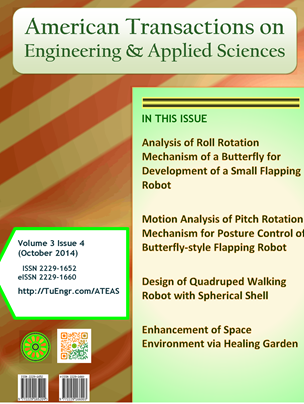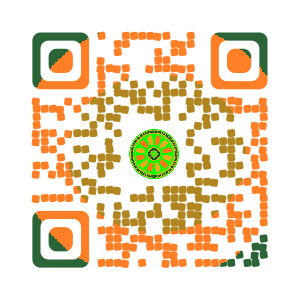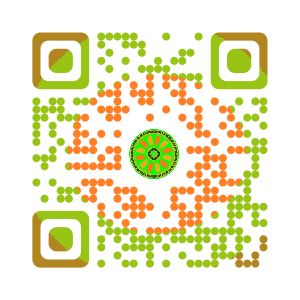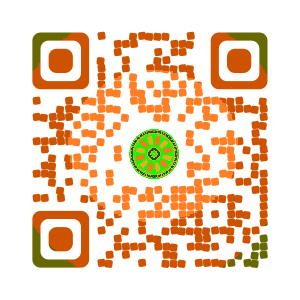- V4(4)Oct2015
- V4(3)Jul2015
- V4(2)Apr2015
- V4(1)Jan2015
- V3(4)Oct2014
- V3(3)Jul2014
- V3(2)Apr2014
- V3(1)Jan2014
- V2(4)Oct2013
- V2(3)Jul2013
- V2(2)Apr2013
- V2(1)Jan2013
- V1(4)Oct2012
- V1(3)Jul2012
- V1(2)Apr2012
- V1(1)Jan2012
:: Vol.3(4) (October 2014)

:: American Transactions on Engineering & Applied Sciences
http://TuEngr.com/ATEAS

ISSN 2229-1652
eISSN 2229-1660

FEATURE PEER-REVIEWED ARTICLES
- Analysis of Roll Rotation Mechanism of a Butterfly for Development of a Small Flapping Robot
- Motion Analysis of Pitch Rotation Mechanism for Posture Control of Butterfly-style Flapping Robot
- Design of Quadruped Walking Robot with Spherical Shell
- Enhancement of Space Environment Via Healing Garden
 Masahiro SHINDO *(Department of Advanced Robotics, Chiba Institute of Technology, JAPAN), Taro FUJIKAWA (Department of Robotics and Mechatronics, Tokyo Denki University, JAPAN ) , Koki KIKUCHI (Department of Advanced Robotics, Chiba Institute of Technology, JAPAN )
Masahiro SHINDO *(Department of Advanced Robotics, Chiba Institute of Technology, JAPAN), Taro FUJIKAWA (Department of Robotics and Mechatronics, Tokyo Denki University, JAPAN ) , Koki KIKUCHI (Department of Advanced Robotics, Chiba Institute of Technology, JAPAN ) Keywords: CFD;
Flapping flight;
Roll rotation;
Posture control;
Aerodynamic characteristics.
Abstract
In this paper, we investigated the aerodynamic characteristics during roll rotation of a butterfly based on computational fluid dynamics using a three-dimensional high-speed camera information. This method allows to create a numerical model of a butterfly from the camera images and to analyze the flow field corresponding to the captured behavior. We photographed two behaviors different in rotational axis and analyzed the roll rotational mechanism. In a typical pitch rotational flight, the differential pressure was concentrated on the tip of fore wings. The magnitudes of reaction forces on left and right wings were roughly matched each other. On the other hands, the differential pressure of the roll rotational flight was distributed in the whole of wings. The magnitude of the right reaction force was twice greater than that of left at the first down stroke. The roll angle changed largely at the same time. These results show that a butterfly rotates about roll by changing the reaction forces on each side.
 Taro FUJIKAWA * (Department of Robotics and Mechatronics, Tokyo Denki University, JAPAN ) , Masahiro SHINDO (Department of Advanced Robotics, Chiba Institute of Technology, JAPAN ) , Koki KIKUCHI (Department of Advanced Robotics, Chiba Institute of Technology, JAPAN )
Taro FUJIKAWA * (Department of Robotics and Mechatronics, Tokyo Denki University, JAPAN ) , Masahiro SHINDO (Department of Advanced Robotics, Chiba Institute of Technology, JAPAN ) , Koki KIKUCHI (Department of Advanced Robotics, Chiba Institute of Technology, JAPAN ) Keywords: Flapping robot;
Butterfly;
Pitch rotation mechanism;
Posture control;
Pitch angle;
Flapping angle.
Abstract
We developed a small flapping robot on the basis of movements made by a butterfly with a low flapping frequency of approximately 10 Hz, a few degrees of freedom of the wings, and a large flapping angle. In this study, we clarify the pitch rotation mechanism that is used to control its posture during takeoff for different initial pitch and flapping angles by the experiments of both manufactured robots and simulation models. The results indicate that the pitch angle can be controlled by altering the initial pitch angle at takeoff and the flapping angles. Furthermore, it is suggested that the initial pitch angle generates a proportional increase in the pitch angle during takeoff, and that certain flapping angles are conducive to increasing the tendency for pitch angle transition. Thus, it is shown that the direction of the flight led by periodic changing in the pitch angle can be controlled by optimizing control parameters such as initial pitch and flapping angles.
 Takeshi AOKI * (Department of Advanced Robotics, Chiba Institute of Technology, JAPAN ), Kazuki OGIHARA (Future Robotics Technology Center, Chiba Institute of Technology, JAPAN )
Takeshi AOKI * (Department of Advanced Robotics, Chiba Institute of Technology, JAPAN ), Kazuki OGIHARA (Future Robotics Technology Center, Chiba Institute of Technology, JAPAN )
(optimized for mobile) /p>
Keywords:
Mechanical design;
Transformable robot;
Disaster robot;
Rescue engineering;
Basic robot experiments
Abstract
We propose a new quadruped walking robot with a spherical shell, called "QRoSS." QRoSS is a transformable robot that can store its legs in the spherical shell. The shell not only absorbs external forces from all directions, but also improves mobile performance because of its round shape. In rescue operations at a disaster site, carrying robots into a site is dangerous for operators because doing so may result in a second accident. If QRoSS is used, instead of carrying robots in, they are thrown in, making the operation safe and easy. This paper reports details of the design concept and development of the prototype model. Basic experiments were conducted to verify performance, which includes landing, rising and walking through a series of movements.
 Ooi Say Jer and Fuziah Ibrahim * (School of Housing, Building and Planning, Universiti Sains Malaysia, MALAYSIA )
Ooi Say Jer and Fuziah Ibrahim * (School of Housing, Building and Planning, Universiti Sains Malaysia, MALAYSIA )
Keywords:
Garden element;
Therapeutic landscape;
Healing factors;
Garden design.
Abstract
Green nature, sunlight and fresh air have been known as important component of healing in healthcare facilities. This paper presents the finding of an exploratory study on healing garden elements in healthcare facilities. The purpose of the paper is to find the elements of healing gardens and its healing factors in the existing garden design. In conducting this research study, site observation and informal interview at selected healthcare facilities have been performed. The study reveals the elements of existing garden design, the interactivity and the end users expectation on a garden. The finding shows that lacking some of the elements of garden design lead to less user friendliness and interactivity in the garden. It also shows that the visibility, accessibility, quietness and comfortable condition in the garden give impact to the utilization of the garden.
Previous: Vol 3(3) April 2014 ......... Next: Vol 4(1) January 2015
Call-for-Papers
Call-for-Scientific Papers
Call-for-Research Papers: ATEAS invites you to submit high quality papers for full peer-review and possible publication in areas pertaining engineering, science, management and technology, especially interdisciplinary/cross-disciplinary/multidisciplinary subjects.
To publish your work in the next available issue, your manuscripts together with copyright transfer document signed by all authors can be submitted via email to Eic @ TuEngr.com (no space between). (please see all detail from Instructions for Authors)
Publication and peer-reviewed process:
After the peer-review process (4-10 weeks), articles will be on-line published in the available next issue. However, the American Transactions on Engineering, & Applied Sciences cannot guarantee the exact publication time as the process may take longer time, subject to peer-review approval and adjustment of the submitted articles.
:: 2014 Rights Reserved
:: American Transactions on Engineering and Applied Sciences